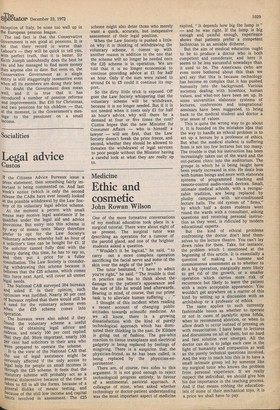Medicine
Ethic and cosmetic
John Rowan Wilson
One of the more formative conversations of my medical education took place in a surgical tutorial. There were about eight of us present. The surgical tutor was describing an operation for a tumour of the parotid gland, and one of the brighter students asked a question.
"Wouldn't it be logical," he said, "to carry out a more complete operation sacrificing the facial nerve and some of the skin over the angle of the jaw?"
The tutor hesitated, "I have to admit you're right," he said. "The trouble is that in practice one has to think about thedamage to the patient's appearance and the sort of life he would lead afterwards.. Bearing in mind, of course, that our prime task is to alleviate human suffering . . ."
I thought of this incident when reading a recent account of changing public attitudes towards scientific medicine. As we all know, there is a growing dissatisfaction with the kind of purely technological approach which has dominated their thinking in the past. Dr Kildare is going out of fashion. The gee-whiz reaction to tissue transplants and electrical gadgetry is being replaced by feelings of misgiving. There is a suspicion that the physician-friend, as he has been called, is being replaced by the physician-experimenter.
There are, of course, two sides to this argument. It is not good enough to reject technological progress entirely, in favour of a sentimental, pastoral approach. A colleague of mine, when asked whether technology or doctor-patient understanding was the most important aspect of medicine replied, "It depends how big the lump is" — and he was right. If the lump is big enough and painful enough, experience shows that patients prefer a competent technician to an amiable ditherer.
But the aim of medical education ought to be to produce a doctor who is both competent and considerate, and here it seems to be less successful nowadays than it used to be. The Americans (who are even more bothered about this than we are) say that this is because technology has become so complex that it has pushed humanity into the background. Various societies dealing with bioethics, human values, and what-not have been set up. In some universities elaborate systems of lectures, conferences and integrational seminars have been suggested, to bring back to the medical student and doctor a true sense of values.
This is quite the wrong way to go about it. It is founded on the mistaken idea that the way to handle an ethical problem is to set up a lecture by a professor of ethics. But what the medical student is suffering from is not too few lectures but too many. The trouble is that his instruction has been increasingly taken out of the ward and the out-patient clinic into the auditorium. The groups in which he is being taught have been yearly increased in size. He deals less with human beings and more with elaborate systems of programmed teaching and remote-control audio-visual devices. Small, intimate medical schools, with a recognizable tradition, are being replaced by plushy campuses with air-conditioned lecture halls. The old system of "firms," by which half a dozen students went round the wards with a consultant, asking questions and receiving personal instruction as they went, is ridiculed by modern educational experts.
But the kind of ethical problems confronting the doctor don't lend themselves to the lecture theatre. You can't lay down rules for them. Take, for instance, the problem which I mentioned at the beginning of this article. It is essentially a question of making a humane and commonsense assessment as to whether to do a big operation, marginally more likely to get rid of the growth, or a smaller operation which carries more risk of recurrence but likely to leave the patient with a more acceptable appearance. You wouldn't get anywhere on a matter of this kind by setting up a discussion with an archibshop or a professor of ethics..
The same applies to such currently fashionable issues as whether to , operate or not in cases of paralytic spina bifida, when to recommend abortion, or when to allow death to occur instead of pressing on with resuscitation. I have been to lectures and discussions on all of them, but no hard and fast solution ever emerges. All the doctor can do is to judge each case in the light of humanity and compassion as well as the purely technical questions involved. And the way to teach him this is to have a small intimate group led by someone like my surgical tutor who knows the problem from personal experience. If we really respect the individual, we should give him his due importance in the teaching process. And if that means robbing the educationists of some of their mechanical toys, it is a price we shall have to pay.










































 Previous page
Previous page